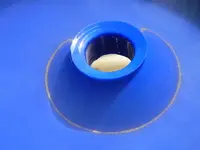Ok, here's the theory on the gap between each mesh size:
If you think about what gets caught in each screen...and therefore panned or blue bowled separately, it is a range of sizes from for example 1/50 of an inch down to just over 1/100 of an inch if using a 50 and a 100 mesh classifiers. So with that range of sizes, a 1/100 inch piece of gold is still heavier than a 1/50 inch piece of "other heavy stuff"...since gold has a specific gravity of 17-19 and silver/lead/iron based sands are s.g. of 5-9. We need the gold to be heavier than the particles around it so our finish separation process is not disrupted a a piece of non-gold blocking a lighter piece of gold from moving the way it should in our pan or crashing into a lighter piece of gold and pushing it when we want the gold to sit still. This teaches us that each mesh should be 2X the prior one and adding more screens wont really change much about the process beyond that..
Of course on the big end (low mesh numbers) none of this is relevant to finish processing...there it is about what works with your field equipment (2-4 mesh for a sluice, 8 for a gold cube...or no mesh for a Bazooka). At home I do 20 and 40 mesh separations after every trip and then once in a while I will take all the non magnetic heavies left over from my routine finish work and run it thru a 50 and a 100 mesh. I posted results from the 100 mesh recently to make the point that all you need to separate the -100 gold (and -200 remembering our relative weight discussion above) is a 100 mesh screen and a pan. With the shake and tap method, that's as quick as a blue bowl or slate table and almost as fast as a $4,000 shaker table...but not quite!
Oh and remember to enjoy the journey!
Ps: yes I know it is silly to go from 40 to 50 mesh but those are the screens I have right now...I could go from 40 to 80 but I don't have one of those...





